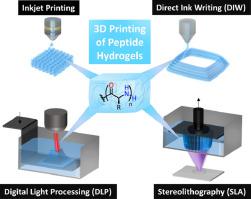Progress in Polymer Science ( IF 26.0 ) Pub Date : 2021-11-28 , DOI: 10.1016/j.progpolymsci.2021.101487 Robert D. Murphy 1, 2 , Ronnie V. Garcia 1, 3 , Andreas Heise 2, 4, 5 , Craig J. Hawker 1, 3, 6

|
Peptide hydrogels have proven to be a critical building block for a range of scientific applications due to their high water capacity, tunable mechanical properties, and modular synthetic design. Particular interest stems from the biomedical realm due to their inherent biomimetic structure and biocompatibility, which has prompted their use as 3D printable matrices. In this review, we will discuss the two main strategies for preparing peptide hydrogels using solid-phase peptide synthesis (SPPS) and N-carboxyanhydride ring opening polymerization (NCA ROP) to construct the linear chains followed by gelation through either non-covalent interactions or covalent crosslinking using light or enzymes as a trigger. These synthetic approaches are summarized with a view to the applicability of hydrogel building blocks in 3D printing and representative examples illustrating the future outlook and possible research directions for the field.
中文翻译:

肽作为 3D 可打印原料:设计策略和新兴应用
由于其高水容量、可调机械性能和模块化合成设计,肽水凝胶已被证明是一系列科学应用的关键组成部分。由于其固有的仿生结构和生物相容性,生物医学领域引起了特别的兴趣,这促使它们用作 3D 可打印矩阵。在这篇综述中,我们将讨论使用固相肽合成 (SPPS) 和N制备肽水凝胶的两种主要策略。-羧酸酐开环聚合 (NCA ROP) 以构建线性链,然后通过非共价相互作用或使用光或酶作为触发器的共价交联凝胶化。总结这些合成方法是为了水凝胶构建块在 3D 打印中的适用性和说明该领域未来前景和可能研究方向的代表性示例。











































 京公网安备 11010802027423号
京公网安备 11010802027423号